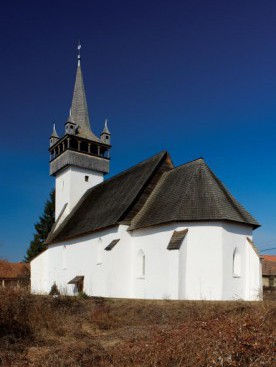The Calvinist Church – Bene
The name of the settlement is probably an abbreviation of the name Benedek (Benedict). The church located at the eastern end of the village shows where the centre of the medieval settlement was. No written sources mention the period when this place of worship was built.
Bene was a smaller regional centre: one part of the settlement belonged to the castle estate of Kovászó/Kvasove, the remaining parts were smaller estates owned by noblemen. The Crimean Tatars set the village on fire in 1567 and dragged the majority of the population away. Forty-seven plots of land remained uninhabited and only five houses were standing after the event.
The sanctuary of this oriented church is 6 metres wide on the inside and is enclosed by three sides of an octagon. It is connected to the nave having a rectangular base, which is 16 metres long and 8 metres wide on the inside. A three-storey tower reinforced by buttresses and located on the side of the nave’s frontispiece also belongs to the church. A sacristy connected to the northern wall of the sanctuary also existed earlier, but it was demolished after the Reformation.
The lower sides of the tower end in straight lines. The western and southern windows of the highest level are spanned by lancet arches, while the northern rose window is a quatrefoil window carved from a single piece of rock. On both the eastern and the southern wall of the sanctuary, there is a lancet window.
Two other lancet windows, slightly greater in size than the previous ones, can be seen on the nave’s southern side. Initially, these were subdivided into two and decorated with traceries. The stone structures forming the windows were tore down in 1906 and the stones composing the archivolts covered by plaster. The lower end of the tracery decoration located earlier in the gable was probably an arc. Such types of Gothic windows were built primarily in the mid-14th century.
On the southern and northern sides of the church, there are two medieval gates spanned by lancet arches. The tabernacle, which contains the sacrament, stems also probably from the Middle Ages. The architectural elements of the church were quite common form the 1330s roughly to the end of the 15th century. Its tower was built most probably later, after the church’s completion.
The openings spanned by lancet arches and the frames carved of stone make up a unitary outlook. Hence, both the nave and the sanctuary must have been built in the second half of the 14th century.
Before the Reformation, the church was embellished on the inside by figural paintings. According to descriptions stemming form the 19th century, the northern wall of the chancel arch was decorated with an image of the Holy Mary holding the dead body of Christ in her arms. The last restoration of the church followed a series of devastating floods that occurred between 1998 and 2001. The Teleki László Foundation financed the works. Both, the church and the tower received a new roof. The architect designed a spire with gallery, balustrade and four pinnacles. The form chosen for the pinnacle harmonises well with the Gothic style determining the entire architecture of the building.










